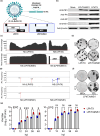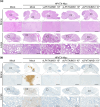A live attenuated NS1-deficient vaccine candidate for cattle-origin influenza A (H5N1) clade 2.3.4.4.b viruses
- PMID: 40652001
- PMCID: PMC12255740
- DOI: 10.1038/s41541-025-01207-9
A live attenuated NS1-deficient vaccine candidate for cattle-origin influenza A (H5N1) clade 2.3.4.4.b viruses
Abstract
Avian Influenza viruses (AIVs) present a public health risk, especially with seasonal vaccines offering limited protection. AIV H5N1 clade 2.3.4.4b has caused a multi-state outbreaks in the United States (US) poultry and cattle since March 2024, raising pandemic concerns. We developed a nonstructural protein 1 (NS1)-deficient mutant of a low pathogenic version of the cattle-origin human influenza A/Texas/37/2024 H5N1, namely LPhTXdNS1, and assessed its safety, immunogenicity, and protection efficacy. LPhTXdNS1 is attenuated in vitro, showing reduced replication efficiency in Vero cells and inability to control IFNβ promoter activation. The LPhTXdNS1-immunized C57BL/6 J mice exhibit significantly reduced viral replication and pathogenicity compared to those infected with the low pathogenic version expressing NS1, namely LPhTX. Notably, a single intranasal dose of LPhTXdNS1 elicited protective immune responses, providing robust protection against lethal wild-type H5N1 challenge. These results demonstrate that LPhTXdNS1 is safe and able to induce protective immune responses against H5N1.
© 2025. The Author(s).
Conflict of interest statement
Competing interests: The A.G.-S. laboratory has received research support from GSK, Pfizer, Senhwa Biosciences, Kenall Manufacturing, Blade Therapeutics, Avimex, Johnson & Johnson, Dynavax, 7Hills Pharma, Pharmamar, ImmunityBio, Accurius, Nanocomposix, Hexamer, N-fold LLC, Model Medicines, Atea Pharma, Applied Biological Laboratories and Merck. A.G.-S. has consulting agreements for the following companies involving cash and/or stock: Castlevax, Amovir, Vivaldi Biosciences, Contrafect, 7Hills Pharma, Avimex, Pagoda, Accurius, Esperovax, Applied Biological Laboratories, Pharmamar, CureLab Oncology, CureLab Veterinary, Synairgen, Paratus, Pfizer and Prosetta. A.G.-S. has been an invited speaker in meeting events organized by Seqirus, Janssen, Abbott, Astrazeneca and NovavaxA.G.-S. is inventor on patents and patent applications on the use of antivirals and vaccines for the treatment and prevention of virus infections and cancer, owned by the Icahn School of Medicine at Mount Sinai, New York. All other authors declare no commercial or financial conflict of interest.
Figures











References
-
- CDC. H5 bird flu: current situation https://www.cdc.gov/bird-flu/situation-summary/index.html (CDC, 2025).
-
- USDA. The occurrence of another highly pathogenic avian influenza (HPAI) spillover from wild birds into dairy cattle. (USDA, 2025).
Grants and funding
- Award # 1520001/Texas Biomed Forum
- contract # 75N93021C00014/Center for Research on Influenza Pathogenesis and Transmission (CRIPT), one of the National institutes of Health/National Institute of Allergy and Infectious Diseases (NIH/NIAID) funded Centers of Excellence for Influenza Research and Response
- contract # 75N93021C00014/Center for Research on Influenza Pathogenesis and Transmission (CRIPT), one of the National institutes of Health/National Institute of Allergy and Infectious Diseases (NIH/NIAID) funded Centers of Excellence for Influenza Research and Response
LinkOut - more resources
Full Text Sources
Research Materials

